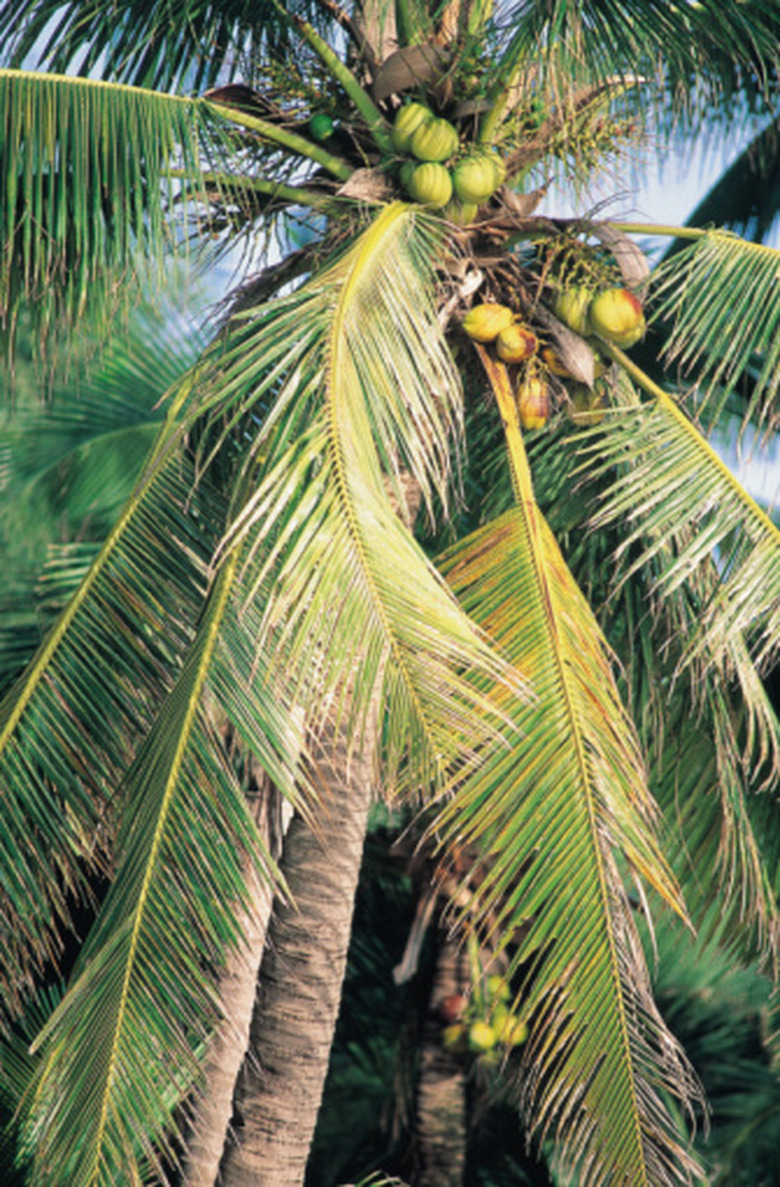Adaptations Of The Coconut Tree
The coconut tree, also known as the coconut palm, is a species of palm tree that produces famously large, hard and tasty fruits called coconuts. When you imagine a coconut tree, you likely also picture a pristine sandy beach, clear blue sea teeming with tropical fish, and bright sunshine filtering through the long branches. Coconut palms grow successfully throughout warm coastal regions across the globe due to their numerous and highly successful survival adaptations.
Coconut Tree Adaptations
Coconut Tree Adaptations
The adaptations of the coconut tree aid this species in many different facets of coastal living. These trees weather harsh tropical storms, survive in unwelcoming environments where other trees fail to thrive and spread their seeds widely and effectively at a greater distance than most other plants can manage.
Coconut Palm Storm Survival
Coconut Palm Storm Survival
As the human residents of many tropical regions can attest, the storms that strike these areas can have devastating consequences on both manmade structures and natural habitats. Despite this, coconut trees (and most palm trees in general) have several unique methods of weathering the kind of storms that easily topple other types of trees.
Where most trees have strong, rigid trunks to hold up lots of heavy branches, palms take a different approach. The long, narrow trunk of a coconut tree has incredibly flexible wood. Instead of the woody rings a "regular" tree produces, palms grow densely packed straw-like structures that have the ability to easily bend under pressure. Their trunk has a structure more closely resembling that of grasses than other trees. When faced with the devastating winds of tropical storms and hurricanes, these trees can bend up to 40 or 50 degrees before succumbing.
Another important adaptation of coconut trees and many other palm species is the structure of their branches. Typical trees have rigid, wide-reaching branches with numerous small leaves. This structure allows them to capture as much sunlight as possible, helping them compete with other trees. However, numerous and wide-spreading branches also provide a larger surface area for the wind to catch, and these branches can have a sail-like quality in a storm – toppling the hapless tree under heavy wind. Coconut trees have a crown of feather-like branches that easily flex and bend, providing little to no resistance against the wind.
Coconut Tree Salt Tolerance
Coconut Tree Salt Tolerance
Beyond the stormy weather, seaside living isn't particularly easy on most plants. The vast majority of plant species cannot tolerate saline soils or salt spray, and cannot survive in the beachy conditions coconut trees live in. For this reason, coconut palms have little to no competition for resources, as few other plants can even live close enough to pose a problem! This species readily grows in sandy soils with higher salt content, and salt spray from the ocean doesn't impact its survival.
Coconut Trees: Unique Seed Dispersal
Coconut Trees: Unique Seed Dispersal
Perhaps the most ingenious adaptation of the coconut tree is the coconut itself. Seed dispersal poses a unique problem to most plants. Some plants use air, some use animals and some simply use gravity to spread their progeny. Coconut trees, however, use the far-reaching ocean currents to disperse their seeds. Coconuts can float and remain dormant for up to 120 days in the ocean before reaching distant shores and sprouting.
Where do coconuts grow? Just about anywhere the current takes them, as long as it isn't too cold for their survival. They do not tolerate freezing temperatures and generally cannot survive in regions with an average temperature below 72 degrees Fahrenheit. Coconut growing also requires significant rainfall, about 30 to 50 inches or more per year. These restrictions generally keep coconut trees growing within the tropical regions that they have become perfectly adapted to survive in.
References
- Treehugger: How Do Palm Trees Survive Hurricanes?
- Livescience: How Do Palm Trees Withstand Hurricanes?
- In Defense of Plants: How Do Palms Survive Hurricanes?
- University of Florida Institute of Food and Agricultural Sciences: The Coconut Palm in Florida
- Annals of Botany: Long-Distance Dispersal of the Coconut Palm
- Invasive Species Compendium: Cocos nucifera
Cite This Article
MLA
Zinni, Yasmin. "Adaptations Of The Coconut Tree" sciencing.com, https://www.sciencing.com/adaptations-of-the-coconut-tree-13427952/. 30 September 2021.
APA
Zinni, Yasmin. (2021, September 30). Adaptations Of The Coconut Tree. sciencing.com. Retrieved from https://www.sciencing.com/adaptations-of-the-coconut-tree-13427952/
Chicago
Zinni, Yasmin. Adaptations Of The Coconut Tree last modified March 24, 2022. https://www.sciencing.com/adaptations-of-the-coconut-tree-13427952/
